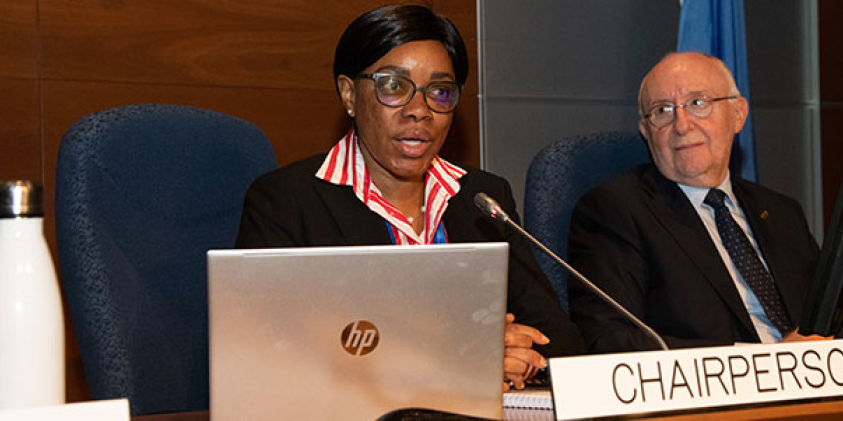ICAO high-level air navigation conference charts path for immediate and strategic enhancements for aviation sustainability

Montréal, 10 September 2024 – Representatives of the world’s governments have endorsed a suite of urgent actions to accelerate the aviation sector's transition to sustainability, while enhancing air safety and boosting operational efficiency.
The commitments emerged from the International Civil Aviation Organization's (ICAO) 14th Air Navigation Conference after nine days of intensive discussions in Montréal involving nearly 900 delegates from 110 ICAO Member States and 28 international organizations.
Their decisions are set to reshape the future of international air travel and transport. "This conference has resulted in concrete and actionable outcomes in critical areas," said ICAO Secretary General Juan Carlos Salazar. "From enhancing the resilience of satellite navigation to facilitating the introduction of electric aircraft, we have laid the groundwork for a safer, more efficient, and environmentally responsible aviation sector. These agreements reflect our sector’s commitment to innovation and adaptability in the face of unprecedented and evolving challenges."
Strategic alignment and technological advancements
Delegates strongly emphasized embracing technological advancements, with agreement on the need for harmonized regulatory frameworks to manage emerging technologies, including electric and hybrid propulsion.
In this context, the conference recommended implementing regulatory sandboxes, in other words, controlled testing environments for new aviation technologies. These sandboxes would allow for the collection of real-world data on emerging technologies like electric aircraft, while also providing opportunities to increase public awareness and acceptance of these innovations.
Another significant outcome of the conference was the call for enhanced mitigation of Global Navigation Satellite System (GNSS) interference, encompassing both deliberate actions like jamming or spoofing, and unintentional disruptions. This growing threat to civil aviation can compromise the accuracy and reliability of aircraft positioning and navigation systems. Recommendations included improved guidance for pilots, better information sharing, and the development of more resilient aircraft systems. There was also broad agreement on the need for a global contingency plan to manage GNSS outages and ensure continued safe navigation.
Operational efficiencies and future-ready systems
The conference established frameworks for the near-term implementation of new procedures on a wider and more consistent scale. These include a specific projects on longitudinal aircraft separation which will safely reduce the distance between aircraft on the same flight path, and free route airspace - a concept allowing more flexible, efficient flight paths between destinations. These initiatives are set to enhance air traffic management worldwide, offering significant performance improvements and operational efficiencies. Additionally, delegates addressed the phasing out of legacy systems, particularly in favor of a more advanced flight planning mechanism, with a targeted global transition by 2034.
Clear direction for necessary steps for trajectory-based operations and the hyper-connected air navigation system was another key outcome of the event. These efforts collectively demonstrate the global aviation community's proactive approach to embracing change and driving progress.
The focus on aviation cybersecurity at the event underscored the importance of safeguarding aviation infrastructure against emerging threats and risks, ensuring a secure and trustworthy environment for all.
Crucially, delegates made commitments to support ICAO's programmatic business planning approach. They also endorsed enhanced strategic alignment of the Global Aviation Safety Plan (GASP) and Global Air Navigation Plan (GANP). These commitments ensure that collective efforts in all these areas and beyond are strategically focused and effectively coordinated.
"The outcomes of this conference reflect our collective vision for a future where aviation continues to connect the world safely, efficiently, and sustainably,” remarked ICAO Council President Salvatore Sciacchitano. “The commitments made here will drive our work programme and set the stage for further progress at the next session of the ICAO Assembly in 2025."
In addition to the ICAO Assembly, the results of this conference will directly inform the organization’s first-ever symposium on advanced air mobility, which officially opened on 9 September at ICAO’s Montréal headquarters.
Au sujet de l'OACIA specialized agency of the United Nations, the International Civil Aviation Organization (ICAO) leads the international alignment of technical standards and strategies, facilitating the safe, secure, and sustainable development of its 193 member states’ aviation sectors and air services. This year, ICAO is celebrating the 80th anniversary of its establishment by the 1944 Convention on International Civil Aviation.
General Contact: communications [at] icao.int (communications[at]icao[dot]int)
Twitter: @ICAOMedia Contact: William Raillant-Clark, Administrateur des communications
wraillantclark [at] icao.int (wraillantclark[at]icao[dot]int)
+1 514-954-6705
+1 514-409-0705 (mobile)
Twitter: @wraillantclark
LinkedIn: linkedin.com/in/raillantclark/